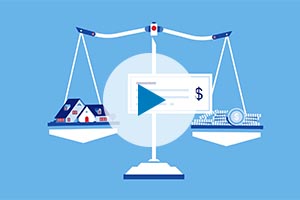
Mortgage basics: How much house can you afford?

Checklist: 6 to-dos for after a move

Dear Money Mentor is designed to answer common consumer banking questions and offer guidance to improve financial wellbeing. Read on for tips and advice from Garret Carter, U.S. Bank production manager for the consumer direct mortgage call center, and Misty Thorne, U.S. Bank refinance sales manager for the consumer direct mortgage call center.
Whether you’ve owned your home for five months or 25 years, you’ve probably heard the term “refinance” and you may have some questions:
Simply put, refinancing is the process of replacing your existing mortgage with a new mortgage that has more favorable terms. It puts you, the homeowner, in a better financial situation. There are many reasons why you may want to refinance, but generally, the decision to move forward with a new mortgage comes down to:
Let’s examine each of these reasons to refinance in detail.
Keep an eye out on interest rates. By refinancing when interest rates are lower – even by a quarter of a percentage point – you could reduce your monthly payments and cut interest rate costs by thousands over the life of your loan. But reacting to a lower rate may not always be the right move for your situation. Reach out to your mortgage loan officer to see if refinancing when the rates are lower make sense for you.
Maybe you were set up with a longer term when you first purchased your home. Now, a couple of years later, your financial situation has changed, and you can afford to make higher mortgage payments. By refinancing to a shorter term, you could pay off the loan quicker, decreasing the amount of interest you’re charged over time.
Beyond saving money, refinancing allows you to tap into equity you’ve built to fund other areas of your life. (Think your child’s college tuition or wedding, home improvements, a dream vacation or wiping out credit card debt.) For example, let’s say you owe $180,000 on your $300,000 home, and you refinance with a $220,000 mortgage. Doing so leaves you with $40,000 to cash out and use however you’d like.
All are valid reasons, but you need to evaluate if refinancing makes sense for your personal and financial situation. Start by contacting your bank or mortgage company – or someone you’re ideally already meeting with for an annual mortgage review. They’ll be able to walk through the current interest rate environment and suggest the best products to fit your needs.
A key advantage for consumers: The mortgage lending industry is heavily regulated. Lenders are obligated to be transparent about costs, rates and fees – essentially the information that will affect your monthly payments. This enables you to shop around with confidence. Since interest rates can change daily, you should try to compare the numbers from lenders in a 24-hour period. That way you’re getting the most accurate cost estimates across the board.
Though refinancing may save you money, it’s important to remember that the process isn’t free. As with any mortgage, there are costs associated with the transaction, which can sometimes be wrapped into the new mortgage. Sometimes these costs are paid out-of-pocket at closing. It’s up to you and your personal banker to determine if those costs are balanced by the benefits of refinancing. Let’s say you’re expected to pay $2,000 in closing costs, but your monthly mortgage payment will be lowered by $200. You’ll recoup the closing costs in only 10 months – in that case, refinancing is worth considering.
If you decide to refinance, the steps will probably feel similar to when you originally closed on your home. Using our self-serve Loan Portal, you can fill out much of the application online and upload paystubs, bank statements and W2s. You can also complete the application over the phone or in any bank branch. After an appraisal determines the home’s value, underwriters will review – and hopefully approve – the loan before a closing date is set1.
In all, refinancing is not as intimidating as it seems. And after an average of 30 to 45 days, your money could be working harder and smarter for you. Here’s to lower monthly mortgage payments, a shorter loan term and/or some cash equity for that dream trip.
Watch this video for more tips on this topic.
Learn more about your refinancing options.
Related content


